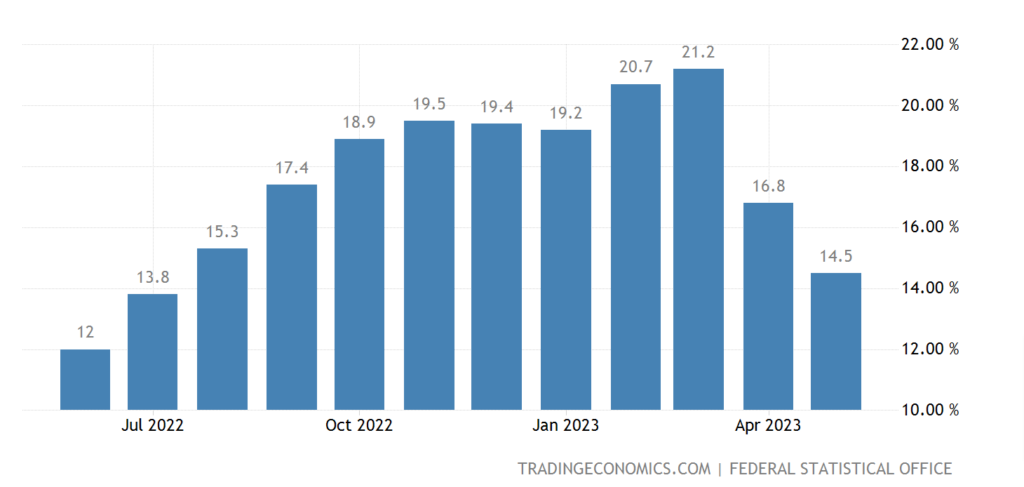Written and fact-checked by business journalist
Leonie Bauer
Food inflation is keeping Europe on its toes. Food prices in the EU have been rising and rising – faster than inflation in general. In May 2023, core inflation reached 6.13%, while food prices were up 15.4% compared to May 2022.
This is partly due to Russia’s war on Ukraine, which is driving up energy and transport costs. Since the invasion, the global markets have been significantly disturbed because Russia and Ukraine have been major exporters of grains, wheat, oilseeds and fertilizers. Supply bottlenecks due to the coronavirus also have a major impact on the price explosion of food and non-alcoholic beverages. In addition, climate change and resulting droughts have reduced grain production.
This article, however, doesn’t focus on the reasons for food inflation. Rather, it’s about the question of what food inflation / foodflation actually means and how you can save money on food despite rising prices.
Which foods have become particularly expensive and which are still affordable? Can you substitute pricy groceries such as meat and eggs with cheaper alternatives without sacrificing nutrients? And how can you plan your grocery shopping in advance without breaking the budget? Read our financial experts’ 8 tips.
What Is Foodflation?
Food inflation, also called Foodflation, is the increase in the price of food and non-alcoholic beverages. It’s been one of the main drivers of inflation in the EU. Prices started to increase in mid 2021 and were exacerbated in March 2023.
The cost of food in the European Union increased by 15.4% in May 2023 compared to the same month last year.

In Germany, the largest economy in Europe, prices have risen even more. Here, food inflation is now at 14.5%, in March it was 21.2%, according to the country’s Federal Statistical Office. The price of edible fats and oils like butter and sunflower oil in the EU saw the sharpest increase, having risen by 23% compared to May 2022.

The pace at which food prices rise matters not just because it directly impacts household budgets, especially for those at the lower end of the income distribution. But also because the visibility of food price changes contributes to influencing the public’s inflation expectations, which in turn can contribute to higher inflation.
Learn more about inflation and its impact on consumers here.
How to Save Money on Food
The slightly decreasing figures above might give the impression that prices are finally returning to normal. Unfortunately, we have to disappoint you. Because even if food inflation is “easing,” prices are not really going down. It merely means that they are no longer rising as fast as before. That’s because inflation and food inflation figures always refer to the same month in the previous year, not to pre-inflation times.
This means that food prices are still dramatically high, with little end in sight. Therefore, learn now how you can save money on food.
1. Avoid Expensive Groceries
Our first tip is not a secret. Avoiding foods that have become particularly expensive in recent months is one of the most effective ways to save money on shopping and lower your personal inflation rate. However, in order to accomplish this, you need to know what foods these are. We have done some research for you.
The groceries whose prices have increased the most are oils, eggs, dairy products, meat and bread.
- Cooking oils and fats: +49%
- Dairy products and eggs: +29,1%
- Meat: +19,5%
- Bread and cereal products: +18,5%
As you can see, foodflation primarily affects animal products. This is due to the increase in prices for feed and the transport of animals and meat. After all, farmers, slaughterhouses and supermarkets have to run their cars on diesel and gasoline. Factory buildings have to be heated with gas and machines run on electricity. So exactly those things that have also risen extremely in price over the last 12 months.
2. Replace Expensive Foods With Cheaper Alternatives
To be able to do without the above-mentioned foods, you need good alternatives. After all, these provide valuable nutrients that our bodies need. But how can you substitute animal proteins and high-fiber cereals without breaking the budget?
We have two tips. First, try to replace half of your meat meals with vegetables. This is especially easy with dishes like meatballs or spaghetti bolognese. Also, you can reduce the size of your steak or filet and serve more side dishes instead. Vegetables such as potatoes, carrots, or legumes such as lentils or peas are suitable.
Second, use more soy products. On average, they are up to 50% cheaper than meat and dairy products and provide valuable vegetable proteins. You can find plant-based meat alternatives (e.g., tofu) in almost all grocery stores that allow you to prepare your favorite dishes at a reasonable price.
3. Buy Organic Vegetables and Fruit
This tip may surprise you because organic products are usually more expensive than their non-organic counterparts. However, in times of inflation, it looks a little different. As fertilizers have increased sharply in price in recent months, non-organic vegetables and fruits have also become significantly more expensive.
However, since organic products grow without fertilizers, their price hasn’t gone up as much as other products. In the EU, organic vegetables and fruit are now about the same price – but organic products are healthier, more natural and less harmful to the environment.
4. Buy Regional and Seasonal Products
Food transported to Europe from far away is currently very expensive. The reason for this is the high price of gasoline and the energy needed for storage. Avoid these price increases by buying regional and seasonal products.
Take strawberries from Europe in the summer, for example. They not only take a short distance to transport from the field to the supermarket, but also don’t require energy to grow in a greenhouse.
5. Research Sales
Another popular tip for saving money on groceries is to search specifically for discounts and deals. You can look for them in supermarket catalogs or in your mailbox.
You can also check online to see which stores are currently offering discounted foods, or bulk discounts. When buying large quantities, however, you should be careful, as we’ll explain in the next chapter.
In addition, there are more and more grocery stores, bakeries and butcher stores that sell expiring goods for less money. Look around in the stores for specially prepared baskets and refrigerators.
And if you don’t want to spend any money at all, you can check out food sharing in your neighborhood. Foodsharing is the practice of collecting unwanted and overproduced food that would otherwise be thrown away and giving it to people who will consume it. Groceries can be collected directly from private households as well as from small or medium-sized businesses.
6. Pay Attention to Package Sizes
Buying food in bulk can help you combat food inflation – if you can afford the upfront cost and have room to store it. If you buy food in bulk and store it in your freezer, pantry or basement, you’ll pay much less in the long run.
But which foods are suitable for buying in bulk? Baking ingredients, such as flour, sugar and cornstarch, bread, frozen pizza, and canned or frozen fruit and veggies. You can also store grains like rice or quinoa, pasta, nuts or nutella and peanut butter for a long time in your pantry.
What are the worst foods to buy in bulk? Cheese, meat, olive oil, fresh or frozen fish and fresh veggies and fruit.
But large packages are not always useful. You only save money if you actually eat the food. Buying in bulk saves money per unit, but you have to be aware of the utility of the extra goods. Even though the price per unit may be low, the total purchase price is higher than the price you would have to pay if you only bought what you needed for a week or a month.
7. Make a Weekly Meal Plan
If you are someone who likes to buy what you feel like on the spur of the moment, this could get expensive in times of inflation. Researchers have found that creating a weekly meal plan can significantly reduce grocery spending.
One of the big advantages of meal planning is you don’t end up overbuying or purchasing too many ingredients and having to throw them all away a few months later. Planning each meal in advance can save a hundred dollars or more on groceries each month.
8. Make Budgeting a Habit
Last but not least, we encourage you to start creating a budget. Specifically, with creating a budget for recurring expenses like rent, utilities, insurance – and food. A food budget is about setting a limit on how much money you can – and want to – spend on food and beverages. You should then not exceed your set limit.
No need to keep a food diary, collect receipts or create an Excel spreadsheet. All you need is a budgeting app like Wallet by BudgetBakers, which you can link to all your bank and neobank accounts. This way, you’ll be able to see how much money you have available and how much you spend on groceries. That gives you the perfect overview of your finances.


